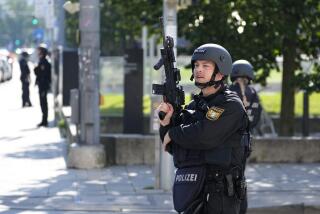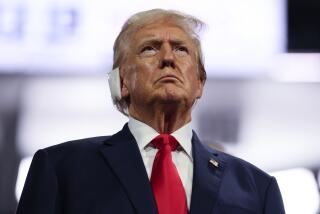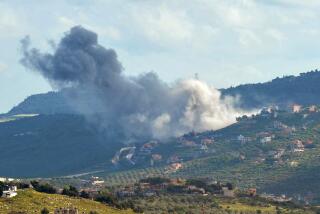U.S. vows ‘justice’ for attack
- Share via
CAIRO — The attack on a U.S. diplomatic post in eastern Libya that killed the U.S. ambassador and three other Americans was carried out by a small group of militants who arrived late at night, unleashed a fusillade from AK-47 rifles and rocket-propelled grenades, then torched and ransacked the building, according to witnesses and U.S. officials.
U.S. officials said the two-hour assault on the U.S. Consulate in Benghazi appeared planned and “complex,” rather than a spontaneous outbreak of mob violence in reaction to an online video, purportedly produced in the United States, that mocks the Muslim prophet Muhammad. The video had prompted protesters to scale the U.S. Embassy walls in Cairo earlier Tuesday and tear down an American flag.
President Obama vowed to work with Libyan officials “to bring to justice the killers,” and ordered security beefed up at U.S. diplomatic missions around the world. The Pentagon sent about 50 Marines from Spain to help guard the embassy in Tripoli, the Libyan capital. The Pentagon is also moving two warships toward the Libyan coast.
The dead included J. Christopher Stevens, 52, the first U.S. ambassador killed in the line of duty since 1979, and Sean Smith, a State Department information officer and Air Force veteran. The identities of the other two slain Americans were being withheld pending notification of their families, officials said.
For the Obama administration, the assault cast a shadow over its support of the “Arab Spring” uprising that overthrew Libyan strongman Moammar Kadafi in August 2011.
Fledgling democracies across the region are struggling to tame dangerous political rivalries and manage movements that have long been suspicious of the West. A new, democratically elected government in Tripoli has sought to exert authority over Libya’s scarred, tribalistic society.
The image of the burned consulate was a sharp contrast to scenes of euphoria in Benghazi, the cradle of the revolt against Kadafi, when the North Atlantic Treaty Organization intervened last year. Then, outdoor prayer services were often decorated with the flags of the U.S. and other NATO countries.
Since then, however, the rivalry between eastern and western Libya has intensified. And Islamist militants long suppressed by Kadafi, especially in Benghazi and other parts of eastern Libya, have reportedly grown in influence.
Libya’s parliamentary elections in July were largely peaceful, and the Muslim Brotherhood finished a distant second in the balloting. But analysts have warned that radical Islamist groups have been looking to exploit a security vacuum.
In recent months, as many as 14 Kadafi regime figures have been assassinated and Sufi Muslim shrines -- viewed by many Islamic extremist groups as heretical -- have been destroyed, with no one brought to justice.
“This shows the problem that we in Libya still face: There is no police force that can control the country. No central authority can control all these different armed, militant groups,” said Mohammed K. Arab, head of political science studies at Tripoli University. “Until we do, we will see continued instability.”
“It is political turmoil that provides militant groups with room to operate, and the uncertain handling of parts of the Libyan transition might have come back to haunt us,” said Sean Kane, a political analyst who has worked in Libya for the Center for Humanitarian Dialogue, a Geneva-based nonprofit group that promotes conflict resolution.
Sen. Bill Nelson (D-Fla.), a member of the Senate Intelligence Committee, said the attacks bore the hallmarks of an Al Qaeda operation and called on the committee to investigate “what role Al Qaeda or its affiliates may have played in the attacks in Libya and Egypt.”
Witnesses in Benghazi said a small crowd gathered Tuesday night outside the consulate, a villa in a walled compound, to protest the anti-Muslim video, which was disseminated online by Morris Sadek, an Egyptian Christian activist in suburban Washington, D.C. Some in the crowd had learned of the protest through Facebook. Others had heard of the video from Libyan students abroad or seen TV images of the Cairo protest.
About 10 p.m., Abdel Monem Monem, a former advisor to the leader of the rebels’ transitional government, went to check and found about 50 people demonstrating without violence.
“It was normal. We were just showing [the Americans] not to insult our prophet Muhammad,” Monem Monem said.
About 11:30 p.m., armed men drove up in about 20 cars bearing Islamic slogans. Sheik Mohamed Oraibi, a young Islamic preacher of the hard-line Salafist movement who was involved in the peaceful protest, watched as what he called “religious extremists” armed with Kalashnikov assault rifles and rocket-propelled grenades arrived and began firing at the consulate. He said he didn’t believe they were affiliated with Al Qaeda.
The compound’s security guards fired into the air to try to disperse the attackers, but the attackers fired back with “ridiculous amounts of gunshots,” Oraibi said.
Fire gutted the compound, according to U.S. officials, and sent U.S. personnel running for safety.
“It’s still very confused,” said a former CIA officer who has spoken with colleagues. “The [American] staff fled into the city and many are unaccounted for. It’s a mess.”
Senior U.S. officials, briefing reporters in Washington on condition of anonymity, said the assailants breached the security walls and fired their weapons, setting the consulate ablaze. The consulate and a separate annex used by U.S. personnel were each protected by Libyan guards and “a robust American security presence,” the official said, declining to provide further details.
Stevens, Smith and a security officer were inside the consulate but became separated as they sought to make their way out of the burning building, the officials said. The security officer made it outside but he went back into the consulate to search for the others.
Finding Smith already dead, the officer pulled him from the building. He was unable to locate Stevens “before being driven from the building due to smoke,” the official said.
The annex, with 25 to 30 other staffers inside, was also under attack. It took about an hour and a half for security personnel to regain control of the consulate and another three hours to completely drive off the attackers, the official said.
The officials said the two other Americans who died were inside the annex and that another two there were wounded.
U.S. officials don’t know where Stevens was when he died or what condition he was in when he was removed from the consulate. “At some point we believe that Ambassador Stevens got out of the building and was taken to Benghazi hospital,” one official said. His body was eventually turned over to U.S. officials at the Benghazi airport.
The dead and wounded, along with the rest of the consulate staff, were flown out of Benghazi early Wednesday on a U.S. Embassy plane from Tripoli, the official said. They were being flown to the U.S. air base at Ramstein, Germany, where the wounded will be treated at the Army’s Landstuhl Regional Medical Center.
The officials refused to comment on who might have conducted the attack.
“It was clearly a complex attack. We are going to have to do a full investigation,” a senior official said. “It’s just too early to speak to who they were and if they might have been otherwise affiliated.”
Amid the gunfire, Jamila Fallad fled to a nearby restaurant. She described the Kalashnikov-toting men as wearing “Islamic beards.”
Fallad met Stevens last year and said she mourned his loss. “I am so sorry for his death. He was a very good man,” she said.
Libya’s interim president, Mohamed Magariaf, apologized to the United States for the attack.
--
sbengali@latimes.com
Parker reported from Cairo and Bengali from Washington. Times staff writers David S. Cloud and Ken Dilanian in Washington and special correspondents Reem Abdellatif and Glen Johnson in Cairo contributed to this report.
--
(BEGIN TEXT OF INFOBOX)
Timeline of events
2011: The movie “Innocence of Muslims” is filmed in California.
July 1-2, 2012: YouTube user “sam bacile” uploads a trailer for the movie, consisting of video clips that mock the Islamic prophet Muhammad.
Sept. 4: An Arabic-dubbed version of the trailer is uploaded to YouTube.
Sept. 5: Morris Sadek, an Egyptian Christian activist living in the U.S., promotes the video on his blog and Twitter in conjunction with “International Judge Muhammad Day,” hosted by Florida pastor Terry Jones and scheduled for Sept. 11.
Sept. 8: Egyptian religious television channel Al Nas airs the video and condemns it.
Sept. 9-10: Sadek continues to promote the video on Twitter. Libyan extremists plan protests for Sept. 11 that are unrelated to the purported movie, experts say.
Sept. 11: Four Americans, including the U.S. ambassador, are killed when militants attack and burn the U.S. Consulate in Benghazi, Libya. In Egypt, protesters scale the walls of the U.S. Embassy in Cairo and tear down an American flag.
More to Read
Sign up for Essential California
The most important California stories and recommendations in your inbox every morning.
You may occasionally receive promotional content from the Los Angeles Times.











